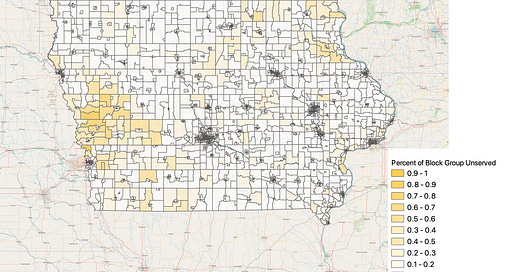The Infrastructure Bill is clear: the $42.5 billion for broadband buildout should prioritize projects for the unserved. Specifically, states should prioritize projects where 80% of the locations served by the project are unserved (see § 60102 (a)(1)(B) and (h)(1)(A)(i)(I)). Only after certifying to NTIA that they can reach all the unserved can a state move on to underserved service projects, where 80% of the locations reached need to be underserved. I believe it will be impossible to reach all the unserved with projects that are 80% or more unserved without gerrymandering the project areas or changing the rules.
Let’s use Iowa as an example. Iowa has 38,714 unserved locations. If we use Census block groups as a proxy for reasonably sized and contiguous project areas (more on that later), a full 0% of unserved locations are in block groups that are more than 80% unserved. In the western part of the state you can find block groups that are almost 80% unserved. And they have neighboring block groups that are also 70%-ish unserved. Probably in that one area you could cut up block groups and build a 80% unserved project. In the rest of the state there is no chance. To reach the rest of the unserved, projects would need to be badly gerrymandered or relax the 80% rule.
Census block groups works well as a proxy for broadband project areas because they’re not too big and not too small. There are 5.9 million populated block groups nationally with an average of 24 housing units per block group. I’m not suggesting that project should follow block group boundaries, only that they work well as a visualization for the concentration of unserved locations.
I zoomed in on a block group in Guthrie County, half way between Des Moines and Omaha north of I-80. There are 982 locations in this block group. It’s 45% unserved, much higher than most of the state. Guthrie and Adair town centers appear to have a fiber provider providing service to most of the locations. But outside the towns, the coverage becomes 500/100 FWA service, then drops to the 25/3 US Cellular FWA and other similar offerings. A compliant “unserved project area” would need to only serve the colorless areas on this map, only picking up a very small number of the light blue hexagons to keep the unserved number at 80% or below.
Iowa has it bad, but it’s not alone. Nebraska also has zero unserved locations in block groups that are 80%+ unserved. South Dakota, Maine, Kansas, North Dakota, Ohio — all those states have very small numbers of unserved locations that are already clustered together.
You can probably see where this is going. Nationally, 1 million of the 7.8 million unserved locations are in block groups that are already 80%+ unserved. By contrast, 3.6 million unserved locations are in block groups that are less than 50% unserved. How is an ISP going to draw a project area that is 80% unserved when most of the locations in the area already have service?
It seems hard — maybe impossible — to reach unserved locations in areas that are less than 30% unserved as part of a project that is 80% unserved. And if we have to reach all the unserved locations before moving on to underserved areas, how do we do it? The only solutions I can think of are to allow gerrymandering of the project areas, relax the 80% rule, or include additional locations as unserved for the purpose of defining the project areas.







Really good point. Seems like it might give an edge to FWA.
All thanks to RDOF that badly screwed up the maps in a lot of rural counties.